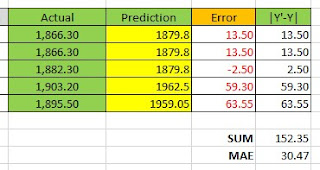Evaluating Models With Root Mean Square Error (RMSE) and MAE
Assalamualaikum, Greetings of Prosperity and Greetings of Culture
The evaluation method of a machine learning model is important to do because it aims to measure the accuracy and accuracy of the methods that have been used. For this reason, at this stage one of the methods that needs to be done is to determine the value of the Root Mean Square Error and Mean Square error
However, it is necessary to note that in machine learning there are two different types, namely Classification and Regression.
Classification is a learning method that predicts a class, for example, whether the class is negative or positive. In a classification problem an algorithmic model tries to predict a class using data during the training phase. In this case it is also called training data.
To test or evaluate the performance of the classification algorithm is to use a testing method with confusion matrix. There are two types, namely binary classification and multi-class classification.
Also Read: How to calculate multi-class confusion matrix.
Regression is a machine learning method that predicts values such as distance, price and age. In regression there is no predicted class but there is a scale and the algorithm model tries to predict the value on that scale.
Meanwhile, for testing of this regression model is to use the value of the Root Mean Square Error and Mean Square Error.
Root Mean Square Error (RMSE)
Root Mean Square Error (RMSE) is the sum of the squared error or the difference between the true value and the predicted value. The RMSE formula is
Example of Settlement
In the table above, you can see that there are two different colors between green and yellow. It shows the true value and the predicted value.
Now, to avoid confusion, we will try to calculate separately
- (1879.8 - 1,866.30)^2 = 182.25
- =SQRT(7925.8425 / 5 )
Mean Square Error (MSE)
- =(7925.8425 / 5 ) = 1585.1685






